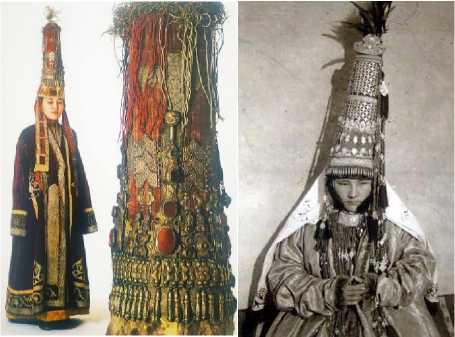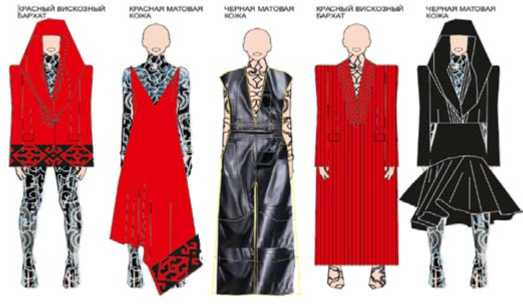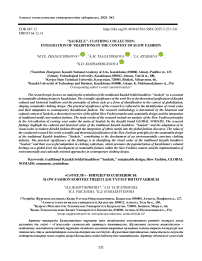"Saukele"- clothing collection: integration of traditions in the context of slow fashion
Автор: Zhanguzhinova M.Ye., Talgatbekova A.M., Rysbaeva I.A., Kozhabergenova K.D.
Журнал: Вестник Алматинского технологического университета @vestnik-atu
Рубрика: Технология текстиля и одежды, дизайн
Статья в выпуске: 3 (149), 2025 года.
Бесплатный доступ
The research topic focuses on studying the symbolism of the traditional Kazakh bridal headdress "Saukele" as a constant in sustainable clothing design in Kazakhstan. The scientific significance of the work lies in the theoretical justification of Kazakh cultural and historical traditions and the principles of ethnic style as a form of identification in the context of globalization, shaping sustainable clothing design. The practical significance of the research is reflected in the identification of visual codes and their adaptation to contemporary Kazakhstani fashion. The research methodology is determined by the historical and cultural context of Saukele, a theoretical overview of the global Slow Fashion market and sustainable design, and the integration of traditional motifs into modern fashion. The main results of the research include an analysis of the Slow Fashion principles in the Art-collection of evening wear under the motto of Saukele by the Kazakh brand GLOBAL NOMADS. The research findings highlight the cultural and historical value of the traditional Kazakh headdress "Saukele" and the adaptation of its visual codes in modern Kazakh fashion through the integration of ethnic motifs into the global fashion discourse. The value of the conducted research lies in the scientific and theoretical justification of the Slow Fashion principles for the sustainable design of the traditional Kazakh headdress "Saukele," contributing to the development of an environmentally conscious clothing industry. The practical significance of the findings is in identifying the visual codes of the traditional Kazakh headdress "Saukele" and their successful adaptation in clothing collections, which promotes the popularization of Kazakhstan's cultural heritage on a global level, the development of sustainable fashion within the Slow Fashion context, and the implementation of environmentally and culturally oriented approaches in contemporary clothing design.
Traditional Kazakh bridal headdress "Saukele", sustainable design, Slow Fashion, GLOBAL NOMADS, ornament, symbolism
Короткий адрес: https://sciup.org/140312210
IDR: 140312210 | УДК: 687.12 | DOI: 10.48184/2304-568X-2025-3-231-241
Текст научной статьи "Saukele"- clothing collection: integration of traditions in the context of slow fashion
UDK 687.12
Introduction.
This research is relevant because it addresses aspects of sustainable design development in Kazakhstan. One such aspect is the traditional Kazakh bridal headdress, the Saukele, which vividly represents the Slow Fashion concept in timeless clothing design. The purpose of the scientific investigation is to explore the potential of the Kazakh Saukele as a symbol of national identity and an object of sustainable design within the framework of the Slow Fashion concept.
While integrating cultural heritage into global Slow Fashion trends, a challenge was identified: the adaptation of a unique aesthetic code within the context of contemporary fashion. A study of the experiences of modern costume designers revealed several problematic situations, particularly in the misapplication and interpretation of the Saukele for different occasions, age groups, and social statuses. Object of the study: Art collections of evening wear under the motto Saukele, developed by the Kazakhstani brand GLOBAL NOMADS. The subject of the study: The integration of the traditional Kazakh bridal headdress Saukele into contemporary fashion within the framework of Slow Fashion.
Research Objectives:
-
1. Examine the historical, cultural, and symbolic context of the traditional Kazakh bridal headdress Saukele.
-
2. Explore the integration of the principles of historical, cultural, and symbolic contexts of Slow Fashion into contemporary fashion.
-
3. Analyze Slow Fashion criteria and develop recommendations for practical applications in clothing design.
The research task includes surveying potential consumers to identify demand for products with an ethnic context.
The study employs the following methods: Art history, cultural, and ethnographic analysis, Theoretical review and analysis, Case studies, Sociological surveys, Research Approaches
The research integrates several approaches, including:
-
• Historical and cultural analysis
-
• Ethnographic approach
-
• Design experimentation
-
• Methodological approaches to sustainable design
-
• Analysis of global fashion trends
-
• Sociocultural and economic approaches
-
• Visual and stylistic analysis
-
• Surveys of respondents (consumers, manufacturers, merchandisers).
Research Hypothesis: the application of historical, cultural, and symbolic contexts of Slow Fashion in contemporary design can serve not only as a means of preserving traditions but also as a tool for the sustainable development of the fashion industry.
Significance of the Study: the integration of visual and symbolic elements of the traditional Kazakh bridal headdress Saukele into contemporary sustainable clothing design, based on the principles of Slow Fashion and sustainable design, contributes to the preservation of Kazakhstan's cultural heritage, the strengthening of national identity, and the formation of a unique aesthetic code that is in demand in the global fashion market.
Thesis for the Article: The Saukele-themed clothing collection illustrates the potential for integrating cultural and symbolic elements of the traditional Kazakh bridal headdress into contemporary fashion design. Rooted in the principles of Slow Fashion, the collection promotes the preservation of national heritage, the popularization of ethnic style, and the development of sustainable fashion. By employing visual codes and ornamental motifs of the Saukele, the collection not only highlights the unique national identity of Kazakh fashion but also creates a distinctive aesthetic code, offering eco-conscious garments that are sought after in the global fashion industry.
Materials and Methods.
Historical and Cultural Context of the Saukele.
The Saukele is a unique and ceremonial headdress worn by Kazakh brides during the wedding ritual. It is one of the most significant symbols of traditional Kazakh culture, playing a key role in the wedding ceremony by reflecting the social status, family prosperity, and cultural traditions of the bride's family. Traditionally, the bride wore the Saukele during celebrations for up to a year after the wedding. The Saukele was preserved as a family heirloom and passed down through generations, embodying traditional historical, cultural, and ethnic values [1].
In exploring the challenges of adapting this unique aesthetic code, the study involved a review of literature from various disciplines related to clothing design, including: Abekova A.Zh., Ashinov R.B., Dahunsi, B., Dunne, L. E., Ezieva M.M., Esenalieva D.B., Erbol A., Frankopan, P., Gagliardi, N., Kudabayeva A.K., Mühlemann, C., Nikolaos Vryzidis, Nosch, M.-L., Rysymbetov E.K., Smal, D., Talgatbekova A.ZH., Turumkozhayeva Zh.S., Woelfle,
H., Zhao, de Wet, F., Zhanguzhinova M.E., Zhumabaeva A.E., Zhumanazarova A.E.
While studying the historical, cultural, and symbolic context of the traditional Kazakh bridal headdress Saukele, the following research question emerged: What principles of historical, cultural, and symbolic contexts can influence Slow Fashion in contemporary fashion design?
The study is divided into the following stages: theoretical and methodological framework, practical implementation, conclusions and recommendations.
In the process of exploring the symbolism of the Saukele, many researchers have identified a universal cosmological concept found in various cultures around the world. According to the theory of the world pillar or mountain, which symbolizes the axis of the universe connecting the heavens, the earth, and the underworld, this axis acts as a bridge between these spheres [2]. The Saukele, with its tall, conical silhouette, is interpreted as a symbol of this axis, reaching from the earth toward the heavens. It accompanies the bride during her transition from one state (childhood) to another (marriage and motherhood), symbolizing an upward movement toward a higher purpose and spiritual maturity. This profound symbolism reflects universal cultural meanings that can resonate deeply in the context of contemporary sustainable fashion.
Through this lens, the Saukele serves as a cultural artifact that not only embodies traditional values but also aligns with modern principles of Slow Fashion by fostering designs with enduring cultural and symbolic significance.
The adornments and ornaments on the Saukele often carry profound sacred meanings. They frequently include cosmological protective patterns and symbols associated with the sun, stars, and other celestial bodies, echoing the concept of the world mountain as the center of the cosmos, surrounded by heavenly lights.
The Saukele symbolized a girl’s transition into the status of a married woman and served as a blessing for wealth, happiness, and health in marriage, as well as the support of the family lineage and ancestors. Patterns and decorative elements on the Saukele often embodied deep sacred significance, reflecting the unique national identity of the Kazakh people [3].
Researchers interpret the Saukele not only as an ethnic symbol but also as a cosmological object, encapsulating universal notions of the world’s structure, spiritual growth, and the human life journey. It represents a worldview and aesthetic concepts that blend cultural, spiritual, and philosophical meanings [3].
The Saukele traditionally features a tall, conical shape, reaching heights of 70–90 cm. Its upper part is adorned with embroidery made from gold or silver threads, and it is encrusted with precious and semi-precious stones such as pearls, coral, turquoise, carnelian, and agate, as well as jewelry crafted from gold, silver, and other semi-precious metals. The Saukele was made using luxurious materials like velvet, silk, sheepskin, felt, and beaver skin.
The color palette of traditional Kazakh Saukele typically includes red and white tones, symbolizing purity and vitality. However, modern interpretations of the Saukele embrace a broader spectrum of warm colors, expanding its aesthetic appeal.
The top of the Saukele is decorated with a long veil and owl feathers, as owls are considered sacred birds in Kazakh tradition and are believed to provide protection. These elements emphasize the sacred and protective nature of the headdress, further enriching its cultural and symbolic significance [4].
This intricate blend of materials, colors, and sacred ornamentation not only highlights the unique craftsmanship behind the Saukele but also provides opportunities to reinterpret its elements in contemporary sustainable fashion, ensuring its relevance and resonance in the global fashion market.
Traditional Kazakh bridal headdresses, Saukele, are always unique and never identical. While preserving a common shape and national ornamentation, each headdress features its own distinctive characteristics. The stylistic design of the Saukele reflects regional preferences across Kazakhstan. For example:
-
• Western Kazakhstan: Saukele from this region are distinguished by massive silver jewelry adorned with geometric patterns.
-
• Southeastern Kazakhstan: Variants from this area are characterized by intricate inlays of precious and semi-precious stones and embroidery with floral motifs.
-
• Central and Northern Kazakhstan: These Saukele are often decorated with fur (such as mink, sable, or fox), embroidery with gold and silver threads (kontil), floral and animal patterns, and ornamental braid trims.
Despite their diversity, the various types of Saukele share a unified set of ideological, artistic, and decorative principles. These principles collectively form symbols of national identity, emphasizing the cultural richness and craftsmanship of Kazakh traditions [5].
Figures 1 and 2 below showcase archival photographs of Kazakh brides in traditional wedding attire with Saukele from the 19th century. These images provide a visual representation of the craftsmanship and cultural significance associated with this iconic headdress.
This combination of regional variation and unified national symbolism underscores the potential for modern reinterpretation of the Saukele in contemporary design, blending tradition with innovation while preserving its cultural essence.

Figure 1, 2. Archival photographs of Kazakh brides in traditional wedding attire featuring the Saukele headdress from the 19th
century.
These images highlight the rich cultural heritage, intricate craftsmanship, and symbolic significance of the Saukele, showcasing its role as a central element in traditional Kazakh bridal attire. The photos serve as valuable visual documentation of historical design practices and inspire contemporary reinterpretations of the Saukele in sustainable fashion.
In the context of the historical and cultural study of the Saukele—the traditional Kazakh bridal headdress—researchers identify it not only as a unique artifact but also as a significant element of national cultural heritage. According to historical and ethnographic literature, the Saukele was crafted from expensive materials and weighed 2.7 kg or more. In the 19th century, its value was estimated at 600 rubles, equivalent to the cost of approximately 60 horses. The use of precious and semi-precious stones in its decoration elevated the Saukele to a high-value item and a symbol of sustainable design, maintaining its relevance over centuries [6,7].
Today, the Saukele continues to play an essential role as a symbol of Kazakh national identity with a unique aesthetic code. It serves as an inspiration for the concept of Slow Fashion, which emphasizes the value, durability, and cultural significance of objects. In contemporary design, the Saukele is a source of ideas for creating clothing, accessories, and scenographic elements, preserving its cultural codes while adapting them to new aesthetic contexts.
Elements of the Saukele are actively used in the collections of modern designers, wedding attire, and jewelry, reflecting efforts to preserve cultural traditions amidst globalization. Furthermore, the Saukele holds a prominent place in cultural events such as exhibitions, festivals, and fashion shows, enhancing the value of cultural heritage within the framework of sustainable development.
This ongoing relevance and reinterpretation of the Saukele illustrate its timeless appeal, making it a cornerstone of both historical and contemporary Kazakh fashion and a vital symbol of sustainable cultural practices.
Thus, the Saukele is not merely a traditional headdress but a reflection of centuries-old history, traditions, and the wealth of Kazakh culture. Its uniqueness and durability affirm the significance of sustainable design approaches, which aim to preserve and develop national heritage within the framework of the contemporary fashion industry.
Based on the conducted research, using the example of the traditional Kazakh bridal headdress Saukele, the principles of historical, cultural, and symbolic contexts for Slow Fashion were identified. These principles include: traditional historical, cultural, and ethnic values, Worldview and aesthetic concepts, a symbol of national identity, a unique aesthetic code. Table 1 presents the principles of historical, cultural, and symbolic contexts within the framework of Slow Fashion.
Table 1. Principles of historical-cultural and symbolic context in Slow Fashion

Traditional historical, cultural, and ethnic values Worldview and aestetic concepts Symbol of national identity Unique aesthetic code
The theoretical analysis conducted on the example of the traditional Kazakh bridal headdress Saukele will help shape the further direction of the research, taking into account the principles of historical-cultural and symbolic context in slow fashion and the possibility of their adaptation in contemporary fashion.
Integration of Principles of Historical-Cultural and Symbolic Context of Slow Fashion into Contemporary Fashion
In contemporary fashion, the adaptation of principles from historical and cultural heritage within the framework of the slow fashion concept is gaining increasing importance. Slow fashion, focused on sustainability, conscious consumption, and respect for traditions, is becoming a significant trend. One striking example of this is the Art Collection of evening wear titled "Saukele," created by the Kazakh brand GLOBAL NOMADS. The authors of the collection are Maya Zhumanbekova and Andrey Burmatikov. This collection was presented at the III International Forum "Fashion Commonwealth" of the CIS. The event brought together over 1,600 representatives from the light industry, creative industries, educational institutions, business communities, and relevant ministries of the Commonwealth of Independent States (CIS) countries [8].
One of the key themes of the forum was the development of sustainable design and the slow fashion concept. These areas have gained particular relevance amid global environmental challenges and the growing interest in conscious consumption. This not only contributes to the preservation of cultural heritage but also opens new perspectives for the creative economy, strengthening the positions of local brands on the international stage. The forum emphasized the need to shift towards more environmentally friendly and responsible approaches to the production and consumption of fashion products [9].
Inspired by the cultural heritage of the traditional Kazakh bridal headdress Saukele as a source of inspiration for sustainable design, Kazakh designers created the Art Collection of evening wear titled "Saukele." The application of elements from the unique aesthetic code of Saukele, such as Kazakh national ornaments like the "ram's horn, flower," textile techniques like "patchwork, quilting," and the distinctive geometric conical shape, as well as the warm color palette, are integrated into modern silhouettes and evening wear. This allows for the promotion of the symbol of Kazakh national identity in the current context.
Below, in Figure 3, are sketches of the Art Collection of evening wear titled "Saukele," created by the Kazakh brand GLOBAL NOMADS.

Figure 3. Sketches of the Art Collection of Evening Wear titled "Saukele" by the Kazakh brand GLOBAL NOMADS
The GLOBAL NOMADS brand interprets Saukele through the lens of contemporary fashion trends, emphasizing its significance as a symbol of national identity and traditional historical-cultural, ethnic values. This integration helps preserve cultural codes and transmit them through fashion, offering new opportunities to rethink historical traditions within the framework of slow fashion.
This approach not only highlights the uniqueness and longevity of design but also demonstrates how the symbolism of the traditional Saukele can inspire the creation of sustainable fashion collections that maintain their relevance in the global fashion landscape. The art collection by GLOBAL NOMADS is an important example of how fashion can serve not only as an aesthetic expression but also as a means of preserving and promoting worldviews, aesthetic concepts, and cultural heritage.
GLOBAL NOMADS integrates principles of sustainable design and slow fashion into their art collections, demonstrating respect for traditions, innovations, and ecological values. The use of ecofriendly and refined materials such as velvet, silk, denim, polyester, viscose, chiffon, brocade, mesh, and eco-leather, along with innovative 3D printing technologies, forms the foundation for creating garments that combine refined style with a mindful approach to fashion [10].
These materials not only emphasize the quality and durability of the products but also contribute to minimizing the negative environmental impact. Velvet and silk add luxury and textural depth, while denim and eco-leather bring in modern accents, demonstrating how traditional fabrics and innovative materials can coexist within the concept of slow fashion.
Below in Figures 4 and 5 are models from the Art Collection of evening wear titled "Saukele," created by the Kazakh brand GLOBAL NOMADS, produced in fabric.

Figure 4, 5. Models of the Art Collection of evening wear under the slogan "Saukele" by the Kazakh brand GLOBAL NOMADS.
The collection by GLOBAL NOMADS serves as an example of how sustainable design can contribute to preserving cultural identity through the integration of local motifs into contemporary fashion, creating clothing that is not only beautiful but also ethical. Thus, the conducted research showed that within the concept of slow fashion, the use of traditional design elements (shapes, proportions, cuts, ornaments, symbols, techniques) that reflect the cultural heritage of the region is relevant. The application of eco-friendly and recycled materials, including natural dyes, an emphasis on high-quality tailoring and durability of products, transparency of the production process, and the exclusion of labor exploitation are crucial in the context of global environmental challenges and the growing interest in conscious consumption [11]. Equally important for sustainable design are versatility, adaptability to different styles and seasons, support for the local economy through collaboration with local workshops, the release of limited collections with unique elements, and the integration of traditional motifs with modern trends [12]. Innovative technologies, such as 3D printing, and the use of history and symbolism to form a unique brand also play a key role in the global fashion industry.
Results and Discussion.
Analysis of Slow Fashion Criteria and Development of Recommendations for Practical Application in Clothing Design
Based on the analysis of the application of historical-cultural and symbolic context principles in slow fashion, a survey was conducted with three groups of respondents from the GLOBAL NOMADS brand: customers, manufacturers, and merchandisers. The total number of respondents was 45 people, with 15 individuals in each group. All three groups were asked the question – to name the key criteria relevant to the potential demand for products with an ethnic context of Slow Fashion in Kazakhstan. The results of the survey revealed the following responses, as presented in Table 2.
Table 2 Criteria for Demand for Products with an Ethnic Context of Slow Design in Kazakhstan
|
№ |
Response Options |
Customers |
Manufacturers |
Merchandisers |
|
1 |
Authenticity and cultural heritage, ethnic context |
95% |
99% |
85% |
|
2 |
Eco-friendliness of materials, durability, and quality |
100% |
100% |
98% |
|
3 |
Ethical production, local brand |
95% |
100% |
75% |
|
4 |
Multifunctionality and versatility, innovative design |
90% |
98% |
88% |
|
5 |
Limited collections (Capsule Collections) |
38% |
87% |
55% |
|
6 |
Informing and engaging the audience |
75% |
90% |
98% |
Based on the results of the survey conducted among the three groups of respondents from the GLOBAL NOMADS brand (customers, developers, and merchandisers), Diagram 1 was created, showing the response options – the criteria for demand for products with an ethnic context of Slow Design in Kazakhstan, presented below.
The criteria for demand for products with an ethnic context of Slow Design in Kazakhstan
120%
100%
80%
60%
40%
20%
0%
1ПП1ПП 1Пп 1ПП .Пп

Informing and engaging the audience
Authenticity and Eco-friendliness ofEthical production, Multifunctionality cultural heritage, materials, local brand and versatility, ethnic context durability, and innovative design quality
Limited collections (Capsule Collections)
□ Customers □ Manufacturers □ Merchandisers
Diagram 1. Criteria for the Demand for Products with an Ethnic Context of Slow Design in Kazakhstan
Based on the analysis of a survey conducted among three groups of respondents from the GLOBAL NOMADS brand (buyers, developers, and merchandisers), key criteria for Slow Fashion relevant to the potential demand for products with an ethnic context were identified.
The study results showed that for all respondent groups, the greatest attention is paid to the sustainability of materials, product durability and quality, authenticity, and cultural heritage.
Comparing the data reveals that each group has its own perception features, but all converge on several key aspects such as ethical production, local manufacturing, limited collections, and the integration of innovative design approaches.
These results suggest that the demand for products with an ethnic context will be high if they meet the requirements of sustainability and cultural tradition preservation, while also combining innovations and ecofriendly practices.
Conclusions
Thus, the conducted research concluded that the importance of integrating historical, cultural, and symbolic contexts, such as elements of the Saukele headdress, into the slow fashion concept contributes to the preservation of national and cultural identity. For designers and manufacturers, it is important to integrate ethnic motifs in combination with eco-friendly materials and modern technologies to create high-quality products adaptable to the global context. Supporting local production, ensuring transparency in processes, and releasing limited collections with a focus on high quality will enhance the uniqueness of the products and the release of exclusive limited collections. Researchers could deepen the study of the symbolism of Saukele and its potential as a foundation for sustainable design, strengthening the role of national traditions in global fashion. Researchers may also focus on studying the symbolic meaning of Saukele and its adaptation within the Slow Fashion concept, which will open new opportunities for the sustainable development of national fashion.


